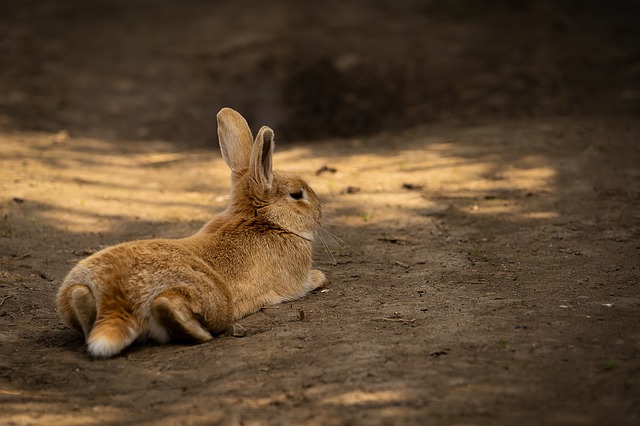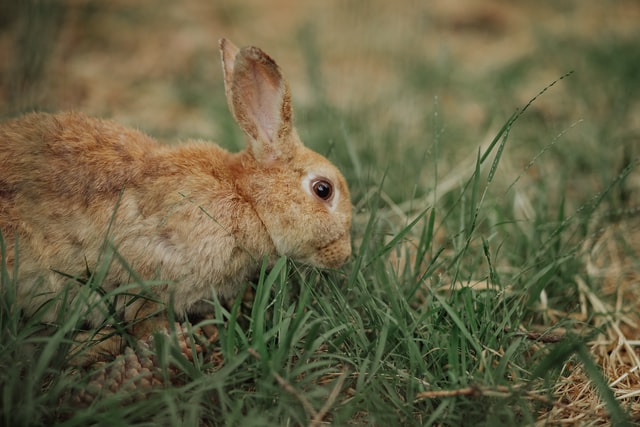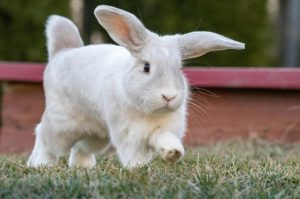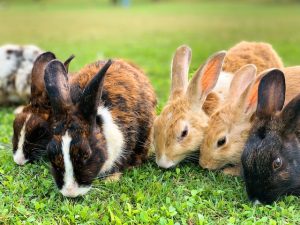
The origin of these gorgeous little bunnies comes from Walter Huey’s rabbitry. He was attempting to improve his Havana breed. After originally being shown against regular Havana rabbits, the American Federation of Havana Breeders deemed the new Havanas a breed of their own. Currently, there are 11 Satin varieties, with 16 mini Satin varieties.
The first litter came out with the Satin gene. After a few more years of trying to perfect the breed, the American Rabbit Breeders Association recognized the Breed as the Satin Rabbit.
Characteristics
The Satin Rabbit has short fur, the fur has a very silky feel and is a roll back type of fur. This means that as a rabbit is being petted, the fur will return to the original position if it is rolled up. The fur also has a gorgeous satin sheen to it. This satin sheen is also a recessive sheen, which means that the hair follicles are smaller than a normal fur follicle on the rabbits. What makes these hairs or fur unique is that there are air bubbles inside each strand of fur that gives it the ability to catch the light.
The ears of the Satin breed stand erect and these Satins all have very bright eyes. The body is considered to be a commercial body, it tapers from the neck down to the tail, as it grows wider on the hindquarters. The Satin rabbit can grow up to 11.5 pounds when it is full grown. She is considered to be of a medium sized breed, and these gorgeous beauties will live to be 7 to 9 years old.
The Satin breed does not require much extra grooming. The fur is short and is the roll back type of fur. This means that as you pet the bunny, the fur will fall back into place if it is brushed in the opposite direction. The Satin will groom himself for the most part. Once the molting season begins, you may want to give your bunny a good brushing to help get the fur off and make the rabbit a little more comfortable. A Satin, like most other rabbits, will go through a heavy molting twice a year.
There are a total of eleven different colors possible for the Satin breed. What you will not find on a Satin is any special markings to distinguish itself.
Temperament and Behavior of the Satin

The Satin breed is one of the best breeds of rabbit to start out with. Singles, seniors and slightly older kids will do well with the Satin breed. When the kit is young, you should be allowing it time out of its hutch for a few hours every day. Socializing is a big part of the daily activities for the Satin breed. Beginning at a young age, they should have interaction with their humans each day. This will help them to become docile and calm rabbits. As you socialize, you will be introducing your rabbit to other people as well as other people.
All rabbits can be trained to use a litter box, but it could take some doing. When working on the training, it should be a reward based type of training. The Satin rabbits are self groomers for the most part. You will need to check their ears routinely for ear mites or built up earwax. The inside of the mouth should also be watched closely for prevention of overgrown teeth. A proper diet will help to keep the teeth from growing too much. Nobbling on a good quality hay will help them keep the teeth down in size.
The Satin rabbit is not predisposed to any certain health concerns. Routine veterinarian consultations should take place so that both you and the vet know that the rabbit is doing good. One main concern is Vitamin D deficiency. If your Satin rabbit is an indoor rabbit, you do need to have the rabbit outside in the sun, or near sunny windows throughout the day.
The Satin breed will be happy living indoors or outdoors. When outdoors, the hutch enclosure should be an open mesh so the sun can shine in. There needs to be some form of protection on the enclosure so that the Rabbit can tuck away during inclement weather. If the bunny is allowed to run outside, there should be a run of sorts. An area that is large enough for the rabbit to get some exercise by hopping, jumping and running. This run or enclosure should also have some protective roof covering it. Predators will not hesitate if they come across an unprotected possible prey.
Diet
The diet for a Satin rabbit is much the same as with all rabbits. At minimum, 70% of the day's food should be Timothy hay. This type of hay provides the rabbit with a wide variety of protein, fiber and calcium. Timothy hay is also one of the most economical types of hay that is good for the rabbits. The rest of the diet should include some leafy greens, fruits and vegetables. It is always wise to follow the advice of the veterinarian as far as any diet concerns.
Mini Version
The Mini Satin is a smaller version of the Satin Rabbit. The mini has the same sheen to its coat of fur. The personality in these little ones matches the coat. They are both shiny and perfect! The Satin Mini has a compact body and will grow to a top point of 4.5 pounds when full grown. The ears of the Mini Satin are erect, can not be any longer than 3.5 inches and they are covered in just as much of the shiny fur.
The Mini Satin has a great temperament, it is calm, friendly and sociable. They should start being introduced to other animals and humans when they are very young. This is what helps with friendliness and makes them a great first pet for almost everyone. Little children will need supervision when with a Mini Satin.
All animals, and humans, for that fact, require personal space. Your Mini Satin is no different. They like their own space and do not want anyone interrupting them when they are resting. The lifespan of a Mini Satin rabbit is generally 7 to 9 years, but there have been some that have lived to 12 years. When a rabbit or other animal are happy and healthy, they can live longer than what is estimated.
There are no breed specific health issues that you need to be aware of in a Mini Satin. They will have the same issues as other rabbits and animals. They could have an earwax build up, which can easily lead to ear mites. They could also get flystrike, which is where the flies lay the eggs by burrowing into the skin of the rabbit. The flies could also lay the eggs in a patch of soiled fur that the Satin Mini can not reach to clean himself.
This is one of the reasons why it is so important to be participating in your rabbit’s everyday life. You will notice if there is any matting taking place on the fur. Then you can get that portion cleaned for your little one. This can lead to severe infections, sometimes fatal. The only other mentioned health concern would be GI Stasis. This is basically when the digestive system shuts down. There will be noticeable loss of appetite, lethargy and no fecal matter.
Routine visits with the veterinarian will help to prevent any issues, as well as the Satin mini’s human taking good care of his or her pet. You should be sure to keep your rabbit up to date with vaccinations and having the deworming medication.
Adoption or Purchase

When you are considering getting a Mini Satin, be sure that you are in touch with a registered breeder. Only they will be able to give you registration papers, a family history and have made sure that the rabbit has had the first vaccinations and deworming. This means that the breeder has already had a visit with the veterinarian for the Mini Satin or the Satin Rabbit.
There are many people who will claim that it is the Satin breed, or even another breed and will not provide papers to prove that this is a registered breed. It may seem expensive when you choose to purchase a Satin or a Mini Satin. This is because they have taken care of the first visit, the shots, the registration and providing the history if asked.
Do not allow someone to tell you that they will mail you papers, the Registration papers should be available the day of sale. Again, if no papers are available, it is likely an unregistered breeder. This could mean that the Satin Rabbit or Mini Satin that you want is not a full breed Satin.





